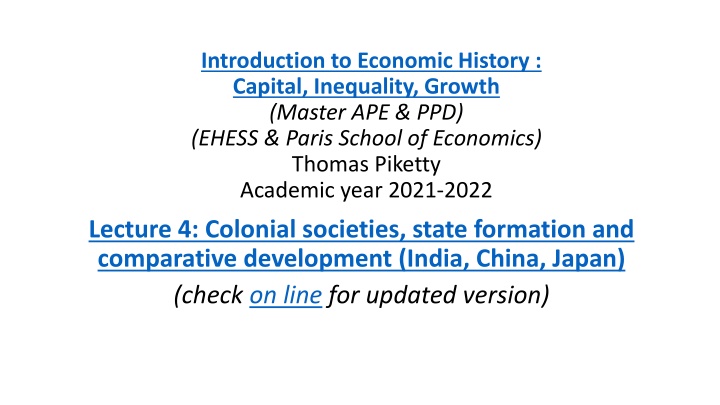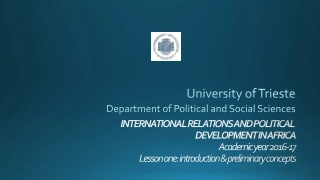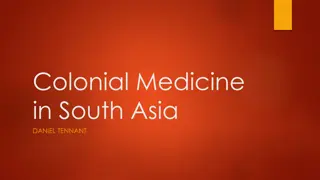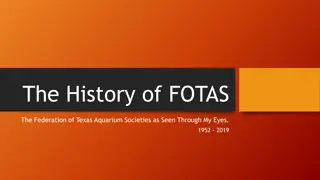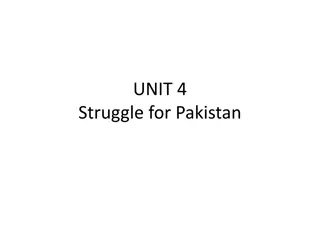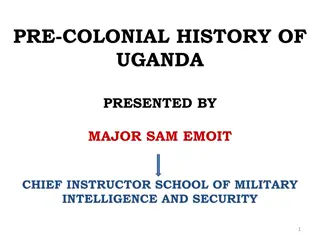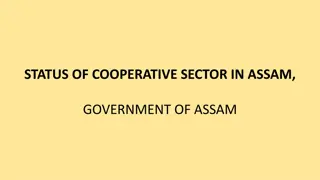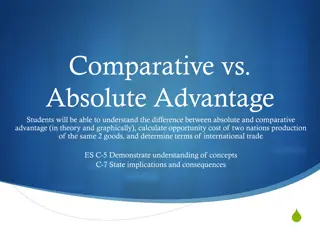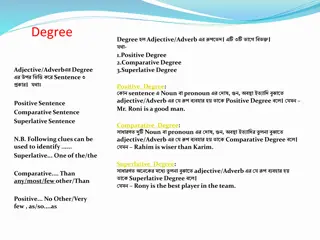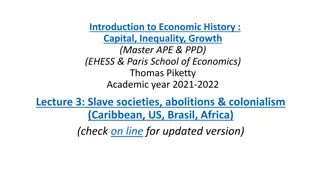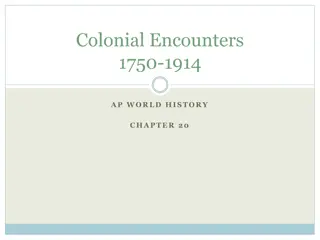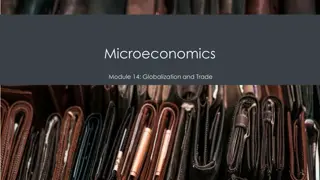Colonial Societies and State Formation in Comparative Development
The lecture explores the impact of colonialism on societies in India, China, and Japan, focusing on state formation, caste systems, and post-independence dynamics. It discusses the role of slavery, colonial domination, and fiscal-military states in the rise of Europe and the industrial revolution, highlighting the importance of globalization and alternative paths for its organization.
Download Presentation

Please find below an Image/Link to download the presentation.
The content on the website is provided AS IS for your information and personal use only. It may not be sold, licensed, or shared on other websites without obtaining consent from the author.If you encounter any issues during the download, it is possible that the publisher has removed the file from their server.
You are allowed to download the files provided on this website for personal or commercial use, subject to the condition that they are used lawfully. All files are the property of their respective owners.
The content on the website is provided AS IS for your information and personal use only. It may not be sold, licensed, or shared on other websites without obtaining consent from the author.
E N D
Presentation Transcript
Introduction to Economic History : Capital, Inequality, Growth (Master APE & PPD) (EHESS & Paris School of Economics) Thomas Piketty Academic year 2021-2022 Lecture 4: Colonial societies, state formation and comparative development (India, China, Japan) (check on line for updated version)
Roadmap of the lecture The rise of Europe & the development of fiscal-military states India and the origins of the caste system (Manusmriti, 2c BC) British colonial censuses (1871-1941) and the rigidification of caste Post-independance India: reservations, inequality & redistribution Colonialism, ternary ideology and modernization: India, Japan, China
The rise of Europe, state capacity & the development of fiscal-military states Slavery and colonial domination played a central role in the rise of Europe and the industrial revolution. In 1860, 75% of cotton used in European textile factories came from US South slavery plantations. Of course this does not mean that slavery-colonialism was a necessary condition for industrialization & development, which certainly could have happenned with a more equitable labour regime and a less hierarchical international order. But this is the way it happened, largely because of European military domination (& ideology justifying using it). See K. Pomeranz, The Great Divergence - China, Europe and the Making of the Modern World Economy, PUP 2000 (Intro.-Chap.5-6) Until 1750-1800, very comparable development level between the most advanced regions of Europe, China, Japan or India (proto-industrialization)
Pomeranz also stresses the role of ecological constraint . Very fast deforestation in Europe 1500-1800 (& China-Japan-India). The discovery of America & the development of Atlantic slavery allowed for large scale imports of raw materials (cotton, wood, sugar, etc.) In 1830s, total English imports = equivalent to 10 millions hectares of land, i.e. 1.5-2 additional Britain in arable land. Modern economic developement is the product of globalization and could hardly have happened without it (i.e. without the world division of labour). The interesting question is to explore the alternative ways globalization could have been organized in past centuries (& could be organized in the future). Armed trade and military domination also played key role in financial innovation: public debt, colonial companies (EIC, VOC, etc.) Not at all the Smithian recipe: low taxes, no debt, peaceful trade, etc.
See S. Beckert, Empire of Cotton. A Global History, Penguin 2014 Until 1500-1600, cotton and textiles had always been produced locally. Things started to change with the Great Discoveries and the military expansion of Europe: the West appropriated land in America, sent slaves from Africa in order to produce raw cottons and finally banned Indian textiles by 1800-1850, Europe was able to gradually take control of global textile manufacturing Key role of slavery: half of the slaves transported over the 1492-1888 period were transported after 1780, and especially in 1780-1820; huge acceleration of the slavery system in 1780-1860 See P. Parthasarathi, Why Europe Grew Rich and Asia Did Not: Global Economic Divergence 1600-1850, CUP 2011. Key role of British bans on Indian textiles. Chine-India: 55% of world manufacturing output in 1800, down to 5% by 1900.
Some on-going research on the ecological and colonial dimensions of the Industrial Revolution and its long-run impact: L. Chancel, Global Carbon Inequality in the Long Run , 2021 on the world distribution of energy consumption and carbon emissions since the Industrial Revolution P. Nogues-Marco, Measuring Colonial Extraction: the East India Company s Rule and the Drain of Wealth (1757-1858) , 2020 M. Stelzner, S. Beckert, The Contribution of Enslaved Workers to Output and Growth in the Antebellum United States , 2021
See also Rosenthal-Wong, Before and Beyond Divergence: The Politics and Economic Change in China & Europe, HUP 2011 They stress the role played by the size of political communities (polities) Europe: smaller polities more competition between small nations- states, more military innovation colonial domination, rise of the West. But also self-destruction of Europe in 20c, and major coordination pb today within the EU China: larger polity less military innovation in 17c-19c, too Smithian (low taxes, no debt, peaceful trade) defeat in Opium wars 1839-1842 and 1856-1860 against Britain & France war tributes, unequal treaties. But maybe better in the long-run
The rise of strong military and fiscal capacity in Europe: consequence of interstate competition. Until 15c-16c all states in the world were weak (<1%- 2% GDP in tax revenues). But in 17c-18c state capacity grew to 6%-8% GDP in Europe, thereby creating a gap with Ottoman or Chinese states (1%-2%) Main explanation: long term process of state-building and ideological change (from trifonctional local elites to proprietarian centralized state). Acceleration of the process due to interstate competition and permanent war in Europe (90%-95% of the time during 16c-17c, 78% during 18c) See K. Karaman, S. Pamuk, Ottoman State Finances in European Perspective, Journal of Economic History 2010 See also M. Dincecco, The Rise of Effective States in Europe, JEH 2015
India and the origins of the caste system India s ideal social structure according to Manusmriti (legal-political- philophical treatise written by a group of priests in the 2ndcentury BCE): four basic classes (varnas) instead of three in European trifunctionnal societies (but same basic logic) Brahmins (priests/teachers) Kshatriya (warriors/rulers) Vaishya (traders/craftsmen) ( skilled labor, free labor) Shudra (laborers) ( common labor, sometime forced labor, quasi-serfs) (+ Dalits (untouchables), not mentionned in Manusmriti) (= specific occupations like working with leather and animal skin, cleaning, etc.) (Dalits = highly discriminated by other groups, like uncivilized aborigenal tribes living in forests and hills)
The Manusmriti is not a sociological or historical description of India in 2c BC (or India in later periods): it is a normative statement written by a group of Hindu priests (brahmins) in order to describe how they believe a well organized Hindu kingdom should look like Basic statement: kings should come from a group of warriors (kshatryas) recognized as such by brahmins, and they should follow the advice of the wisest brahmins, in particular regarding wars, religious and family matters, property and inheritance division, etc. (very sophisticated legal code) It is comparable to 10c-11c AC texts written by European bishops describing the ideal trifunctionnal structure of society: priests vs warriors vs others In practice, the social and political reality is always more complex & chaotic: new groups of rulers kept replacing each other for centuries, both in India & in Europe (& elsewhere), and priests/intellectuals have always faced strong difficulties to put discipline on them & elicit respect for their vast knowledge
In pre-colonial India (like in Europe), the social structure was in practice much more complex than a three-class or four-class structure: there were thousands of small occupational-regional-ethnic groups (jatis) E.g. Kerala shoe-makers, Bengali goat-raisers, Punjabi cultivator, etc. The European view of Indian castes has always been characterized by a major confusion between castes as varnas (the four theoretical classes of the Manusmriti) vs castes as jatis (the thousands of small social groups, with multiple and changing social identities and boundaries) There was no formalisation of the system until the Caste Censuses conducted in 1871-1941 under British colonial rule, which contributed to create rigid administrative categories out of a highly decentralized social structure In addition to the enormous regional, linguistic and ethnic diversity, India s complex social and political structure is also characterized by an early experience with multiconfessionalism (Islam plays important role since 12c)
India 10c-19c: permanent competition beween multiple states of different confessions: Moghul empire (maximal extension 1526-1707, final fall 1858), various muslim sultanates and hindu kingdoms, including Maratha empire (1674-1818), Vijayanagara kingdom (Kerala), etc. British India: EIC 1757-1857 (East India Company), direct rule 1858-1947 (British Raj, but 562 princely states & various political entities until 1947) On the rapidly evolving social and political structure of 18c-19c India, see N. Dirks, Castes of Mind: Colonialism and the Making of Modern India, PUP 2001; S. Bayly, Caste, Society and Politics in India from the 18c to the Modern Age, CUP 1999 On Europe s discovery of India, see S. Subrahmanyan, The Career and Legend of Vasco de Gama, CUP 1997 (Vasco de Gama. L gendes et tribulations du vice-roi des Indes, Alma 2012)
British colonial censuses (1871-1941) and the rigidification of caste After the Indian revolt 1857-1858, British rulers aimed to better control the country. In particular, they organize major decennial censuses (critical source of knowledge for organizing the tax system, maintaining social order, etc.) Pb: they did not know which social categories to use in order to describe and register Indian society. They started from the four varnas of the Manusmriti (brahmins, kshatryas, vaishyas, shudras), but they soon realized that these categories did not correspond at all to the way the various social groups describe and perceive themselves (people used jatis, not varnas). 1871 census: 3 208 jatis are counted 1881 census: 19 044 jatis and subjatis (<20 000 individuals per jati) (=very small local occupational-ethnic-linguistic categories)
Imagine a situation where an Indian ruler takes over Europe in the 18c-19c and attempts to put the population of the entire continent into boxes: carpenters from Creuse, nannies from Britanny, Catalan grape-pickers, Scottish shepperds, Finnish fisherman, etc. British colonial administrators had no idea on how to classify these thousands of local jatis into broad meaningful categories See e.g. Nesfield, Brief View of the Caste Sytem of the North-Western Provinces and Oudh, Together with an Examination of Names and Figures Shown in the Census Report 1882, Allahabad 1885 Interesting illustration of both the hesitations and the prejudices of colonial administrators against lower social groups (untouchables, aborigenals and other lower groups are accused of being dirty, permissive, thieves, etc.). In effect they just reproduce the prejudices of Indian upper classes against lower groups (like Victorian bourgeois prejudices against working classes)
In colonial censuses 1871-1931, British administrators attempt to classify dozens of jatis into one unified category of brahmins (groups of former or current priests/teachers/doctors/landlords etc.), kshatryas/rajputs (groups of former or current soldiers/warriors/land owners etc.), vaishyas/banyas (traders, etc.), but in practice this is highly artificial, because the boundaries between the different social groups cannot always be classified in these terms See this directory for exemples of the statistical volumes of census results Using these definitions, one finds that the weight of brahmins and kshatryas in India 1871-1931 was comparable to the weight of the clergy and nobility in 16c-19c Europe: close to Spain (8%-10% of total pop), < France-UK (2%-5%)
In 1871-1931, British colonial censuses are used to distribute rights and duties and to maintain social orders: brahmins & kshatryas/rajputs are useful categories to hire administrators & policemen/soldiers, enforce social privileges and organize tax collections (indirect tax collection via local land-owning elites) Census questionnaires involve a complex mixture of self-reporting, identity manipulation, local council and administrative approval: see e.g. Cassan, Identity based policies and identity manipulation: Evidence from Colonial Punjab , AEJ 2014 Caste censuses were also used in order to register and criminalize dangerous lower groups: Criminal Tribes Acts
Between 1871 and 1931, British rulers gradually realized that the rigidification and bureaucratization of caste identities contributes to create and exacerbate social conflicts, and was being strongly opposed by independance movements (Indian National Congress created in 1885) They finally decided to abandon the registration of upper castes in 1931: the 1941 census has no general questionnaire on castes Post-1947 Indian governments focused upon the correction of past discrimination against lower castes & stopped asking general questions about caste identities in censuses But the 1871-1931 experience with colonial censuses seems to have contributed to rigidify upper caste identities: in 1962-2014 electoral surveys, self-reported brahmins and other upper castes appear to account roughly for the same proportion of the population as in colonial censuses; upper caste identity still matters a lot today for political affiliation (BJP vote)
Some modern surveys still ask questions about caste identity and show that there is still a strong correlation (but with lots of exceptions) with socio- economic inequality E.g. in the 1990s-2010s, like in colonial censuses 1871-1931, one observes that brahmins have very high education, property and income, while kshatryas/rajupts have high property and income (but lower education) (intellectual elite vs warrior/business elite) (see N. Bharti, Wealth Inequality, Class and Caste in India, 1961-2012, WID.world 2018) (long version) Quotas/reservations favouring access to university and high administrative positions started in princely states in ealy 20c: 1902 Kolhapur (local king humiliated by Brahmins due to his shudra origins 50% quota for non- Brahmins), 1916 Madras, 1918 Mysore (non-Brahmin elites don t accept any more that 3% Brahmin population captures 70% of university seats and high civil servant positions), 1921 Tamil Nadu British colonialism and state centralization did not create Indian inequality; but they gave a rigid administrative structure to caste and class in India (as well as a toolbox for self-correction, to some extent)
Post-independance India: reservations, inequality & redistribution 1950 Constitution: no state religion, abolition of all caste privileges, end of untouchability, open access to all temples & public spaces (art.14-15); but large state autonomy to regulate cow slaughtering (art.46) ( lower castes & muslims regularly accused of illegal cow slaughtering violent riots) Art.46: quotas/reservations for SC (scheduled castes: Dalits, former untouchables) and ST (scheduled tribes: former aborigenals) in higher education, public sector jobs and elected positions, in proportion to population share these SC/ST reservations were implemented immediately (Poona Pact 1932 Ambedkar-Gandhi: no separate electorate for Dalits, but quota systems for elected positions; reserved seats drawn at random) Art.340: quotas/reservations should later be enacted for OBC (other backward classes) ( = other social groups suffering from objective material deprivation education, income, housing, etc. but not due to specific past discrimination)
In 1950-1992 the reservations only applied to SCs-STs at the federal level. In some states, they were gradually extended to OBCs, as well as to the poorest groups within Forward Castes (FC). Federal extension of quota systems to OBC (Other backward classes): Mandal Commission 1980, final validation & implementation in 1992 The OBC extension deeply transformed the logic of quota systems: with quotas limited to SC-ST, only 20%-25% of seats in university and public sector were reserved for lower social groups (not a big threat for children of upper classes). But with OBC, up to 60%-70% of seats were potentially reserved for lower social groups ( this became much more dangerous for upper class children) Indian Muslims (14% pop) did not benefit from SC-ST status but could benefit from OBC status. Major source of conflict with Hindu nationalist parties since the 1990s-2000s ( rise of BJP), but also key factor of solidarity with lower caste hindus. Low-caste parties (BSP, JP) & INC are supported both by lower class muslims and lower class hindus.
Did Indian quotas work? Yes and no. Yes. Past discrimination against SC and ST was so large than it was necessary to use positive discrimination. It worked in politics: all parties now have 25% of SC-ST elected officials. This contributed to the inclusiveness of Indian democracy. See F. Jensenius, Social Justice through Inclusion: The Consequences of Electoral Quotas in India, OUP 2017 See also Duflo et al, Powerful Women: Does Exposure Reduce Bias? , QJE 2009, about declining steretorypes against women s political discourses among voters after being exposed to female politicians. It worked in economics: inequality between SC-ST and the rest of the population is still very large, but since 1950 is has declined a lot more for instance than black-white inequality in the US
Are quotas sufficient? No. Given the small number of seats in university, public sector jobs & elected positions, one cannot solve the Indian inequality problem simply by an approach based upon reservations. One would need more investment in basic social services (education, health), redistribution in land and other assets (limited land reform took place in Kerala and West Bengal), etc. 2010s: public health spending = 1% GDP in India, vs 3% China & 8% Europe For the Indian elite, support to the reservations system has sometime served as an excuse to avoid more ambitious redistributive policies Nehru-Gandhi and Ambedkar disagreed about quotas vs separate electorates, but shared fairly conservative view about taxation & property Education & health: India lagging behind China, Vietnam, Bengladesh.. J. Dr ze, A. Sen, An Uncertain Glory. India and its Contradictions, PUP 2013 (see also India. Economic Development and Social Opportunity, OUP 1995)
Ideally, quota systems should plan the conditions of their own transformation, as stereotypes gradually disappear. Otherwise there s a strong risk that quotas contribute to rigidify past categories and to perpetuate/exacerbate identity-based conflict. In 1993, creamy layer (household income > 800 000Rs, i.e. top 10%) were excluded from OBC status (& from SC-ST status since 2018). In 2019, new quotas were introduced for upper castes (FC) below 800 000Rs were introduced, to the expense of FCs above 800 000Rs. A Socio-Economic and Caste Census was conducted in 2011 in order to clarify the relation between caste, education, income, wealth, housing conditions & poverty (=first caste census since 1931 British census), but full results have not been published yet (very explosive issue) It is possible that India s caste-based reservation system has started a long process of transformation into an income- & wealth-based reservation system. But this will take time. Many lessons for the rest of the world.
Colonialism, ternary ideology and modernization: India, Japan, China Colonialism had a major impact on the modernization trajectories followed by the various societies and the way they evolved from trifonctionnal to proprietarian and post-proprieterian ideologies India: rigidification of caste via British colonial censuses 1871-1931 Iran: muslim clergy managed to appear as the main force of resistance against colonialism and corrupt military-business elite 1979 revolution, theocratic republic dominated by clergy Japan: major trauma after 1853-1854 humiliation by Western navy Meiji era 1868, end of Shogun & traditional warrior class power, huge investment in industrialization and education (& military)
In effect, this induced an acceleration of trifunctional-proprietarian transition & the modernization trajectory in Japan Burakumin in Japan (quasi-untouchables, see Carr Annales HSS 2011) were gradually integrated into the rest of society via modernization and the rise of the social and educational state in late 19c and early 20c Japan 1870-1940: very different strategy of development and social integration than India under British rule (colonial British rulers were happy to divide and rule Indian society and did not care much about equality, education and social integration, unlike Japanese rulers in Japan) Different trajectories and bifurcations are possible: the development state can put an end to historical prejudice and discrimination Roms in Europe: massive prejudice until today (comparable to Dalits in India) (=ex-serfs and slaves not integrated following emancipation in Romania 1865)
Trifonctional ideology, imperial regime & colonialism in 19c Imperial China Imperial China: very weak state (tax revenues<2% GDP), relying extensively on local elites (like in Europe until 16c-18c) Confucean intellectual-landowning elite vs Mandchu warrior elite Same ternary logic as Europe, India, Japan, Iran, etc. (but Confucianism was more a civic religion than a religion in the Christian, Hindu or Muslim sense) Very competitive exam to become top civil servants (mandarins) But 50% of the central govt positions were reserved for Mandchu warrior class (with their own dedicated channel for appointment) Out of the 50% of the seats opened through the standard exam, about half of the candidates were allowed to buy the shengyuan (bachelor degree) required to take the exam (see e.g. H. Yifei, Social Mobility & Meritocracy: Lessons from Chinese Imperial Civil Service Examination, CalTech 2016) fragile mixture of intellectual, proprietarian and warrior-class ideology
Legitimacy of imperial elites strongly damaged by Opium wars (1839-1842 and 1856-1860) and especially by Taiping revolt (1850-1864): 20-30 million people killed (>WW1). Taiping ideology: mixture of egalitarian land reform and Christian messianism. Major threat to the imperial regime, which might not have survived without the final support of European powers. Military defeat against Japan 1895, Boxers revolt 1899-1901 final loss of legitimacy of imperial regime 1911 Revolution Constitution of 1911: proprietarian-conservative republic (Mandchu warrior elite is suppressed, but intellectual-proprietarian elite is maintained, with no redistribution of land toward poor peasants) Civil war & colonial Japanese-European occupation 1911-1949 Communist victory, People s Repubic of China established in 1949 Like Russia, China shifted almost directly from trifunctionnal ideology to communist ideology during 20c
General lesson (lectures 1-4): large diversity of modernization trajectories. The feudalism-capitalism transition (French Revolution, invention of modern property) is only one of many possible trajectories and often involves more complex evolutions (British Lords, Swedish voting rules, etc.). Key role of slavery & post-slavery trajectories (US, Brasil, Africa) and colonial & post-colonial bifurcations (India, Iran, Japan, China, etc.). Politics & ideology about the inequality structure matter: crisis & revolutions come again and again and can lead to many different alternative legal regimes & socio-economic systems. See lectures 5-6 on the fall of proprietarian and colonial societies during 20c and the rise of social-democratic, communist, post-communist and post-colonial societies in late 20c-early 21c
